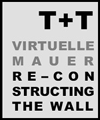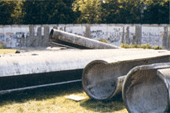
Location
Based on extensive research we selected the area stretching from Heinrich-Heine-Strasse
to Bethaniendamm/Engeldamm as the "virtual stage" for our project
Virtuelle Mauer / ReConstructing the Wall. We then investigated
how the presence of the Wall affected the environment of the site, its
urban development and the events that transpired here due to the presence
of the Wall. We examined the area around the border crossing at Heinrich-Heine-Strasse,
the densely populated inner city quarters that were divided by the Wall,
and the post-Wall changes that took place in the wastelands left by the
Death Strip. (See also the link "Site.").
Border Structures
From its initial provisional construction in 1961 until its fall in 1989
there were a total of 4 "generations" of the Wall, each with
a different structure and composition, that we investigated for our selected
site. We also investigated urban development of the area around the Death
Strip after the fall of the Wall, parts of which have changed beyond recognition.
Daily Life "in the Shadow
of the Wall"
A further part of the research was to investigate the personal, political
and historical context by interviewing people who "lived with the
Wall" as well as historians, city planners and historic preservationists.
These diverse points of view provide us with important information and
new insights into the total context created by the Wall in Berlin. Our
goal was to be able to convey the extremely diverse situations and lived
realities in East and West, such that users of the VR installation Virtuelle
Mauer/ ReConstructing the Wall could experience themselves what
it meant to live "in the shadow of the Wall."
| Home |
| Introduction |
| Site |
| > Development |
| Presentation |
| Documentation |
| Artist Team T+T |
| Supporters |
| Berlin Wall Links |
| Events |

[ Research ] [ Dramatic Concept ] [ Hyper-Storyboard ] [ VR Production ]